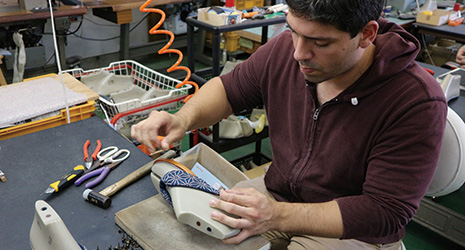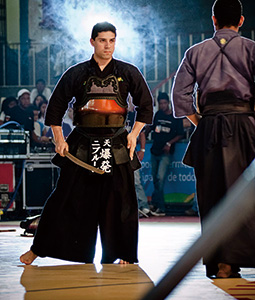Home > Highlighting JAPAN > Highlighting Japan December 2017 > My Way
Highlighting JAPAN


Kendo, Geta and the Japanese Spirit
A young Brazilian man who came to Japan with a love for kendo has carved out a career as a maker of geta, traditional Japanese wooden sandals.
The Tokaido Road is an important route that was constructed in 1601 and connects Nihombashi in Tokyo with Kyoto along the Pacific Ocean. An important point on the road, Shizuoka City in Shizuoka Prefecture, has a long reputation as a producer of quality footwear. Mizutori Industrial Co., Ltd. which started business in Shizuoka in 1937, originally produced traditional geta, but twenty-five years ago it started to develop and sell an improved version that is easier to wear. Geta are made of a cloth thong secured to a wooden platform. They are worn by pinching the thong between the two innermost toes. Because the geta made by the company are well-designed and comfortable to wear, they are suitable for modern life and casual wear, and are popular among people of all ages.
Marcos Da Paz Brum from Brazil works on the production of geta at Mizutori Industrial Co. alongside Japanese craftsmen.
Marcos explains why he became a geta craftsman:
“I longed for geta worn by the characters in movies by director Akira Kurosawa. When I walk wearing geta, I enjoy the soothing sound of wood and I look refined.” He adds, “In Japan, people also build wooden houses and use many daily tools made of wood. I really like wooden geta because they are very Japanese.”
Marcos has been interested in Japanese culture since childhood and practiced kendo (Japanese fencing) and naginata (Japanese halberd) at an old martial arts training school run by a Japanese-Brazilian instructor in Rio de Janeiro. There he met a Japanese woman who had come to Brazil for a kendo match and later married her. When his wife gave birth in 2012, they moved to her hometown in Shizuoka City.
Marcos was impressed by his new home’s close proximity to Mt. Fuji. He says, “In Rio, fencing instructors told me to fight with dignity, as fairly as Mt. Fuji. This is also true in life. They also taught me not to run away from challenges. Looking at the actual, magnificent and beautiful shape of Mt. Fuji, I was finally able to understand what he meant.”
In his first year in Japan, Marcos studied Japanese, helping with tea farming at his wife’s family home. An acquaintance of his father-in-law introduced Marcos to Mizutori Industrial Co. in 2013. He was still unable to completely understand Japanese and had a difficult time making geta because the work involves many fine and delicate tasks, but gradually he acquired the skills with the help of his seniors and now he teaches new apprentices.
Marcos recommends geta made from hinoki (cypress). Because geta are worn barefoot, hinoki, which is a soft wood, feels particularly comfortable. In addition, the grain is beautiful and the wood has a wonderful scent. The hinoki used for the geta produced by Mizutori Industrial Co. is harvested in Shizuoka Prefecture. Shizuoka is also a leading producer of other wooden products, such as furniture and Buddhist altar fittings. Mizutori Industrial Co. incorporates furniture-making techniques of Shizuoka. It creates products by processing them so that even the thin platform for geta is of sufficient strength. In addition, the company’s geta are characterized by their perfect fit with the shape of the feet and their lightness and ease of wearing. Looked after carefully, they will last for many years.
Marcos puts a lot of energy and attention into mending work. He repairs the bottoms of worn geta platforms. If there is a weak part, he carefully repairs the geta preserving the original shape and color with consideration for the user. Marcos also puts his heart into making geta for children.
“Geta are an effective way to develop flexible toes and a strong grip, making them good footwear for children,” says Marcos with a soft smile. “The challenge is to adjust the thongs so that they will not be too tight but are still easy for children to wear.” Of course, Marcos’s small children also enjoy wearing the geta he makes.
Marcos still continues to practice kendo and spars with his father-in-law, who teaches kendo to local children in the city. Marcos believes that you can learn the Japanese spirit by practicing kendo, which values propriety and shows respect for others. Marcos says, “I think consideration for others lies at the foundation of all Japanese culture. I want to disseminate geta worldwide, while also sharing the depth of Japanese culture, but I still have a long way to go.”
© 2009 Cabinet Office, Government of Japan








